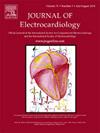Sudden cardiac arrest in patients with hypertrophic cardiomyopathy: Are there electrocardiographic predictors?
IF 1.2
4区 医学
Q3 CARDIAC & CARDIOVASCULAR SYSTEMS
引用次数: 0
Abstract
Background
Hypertrophic cardiomyopathy (HCM) predisposes patients to cardiac arrest (CA). While established major risk factors may warrant the need for primary prevention by implantable cardioverter-defibrillator (ICD), it is unknown if specific electrocardiographic predictors are associated with CA. Our objective was to determine the risk of CA in patients with HCM based on the presence of identified electrocardiographic arrhythmias and conduction disorders.
Methods
We queried the National Inpatient Sample (NIS) from 4th quarter 2015 to 2020 to identify adult hospitalizations with HCM via ICD-10 codes excluding those presenting with syncope and those who had an ICD implant. We compared the odds of having CA in those with atrioventricular (AV) block, bundle branch block (BBB), atrial fibrillation (AF), atrial flutter (AFL), supraventricular tachycardia (SVT), and premature ventricular contractions (PVCs). Regression models were used to adjust for underlying medical comorbidities and patient demographics.
Results
Of 251,450 HCM hospitalizations, 12,573 (5 %) were associated with CA. Those who had CA were younger (63 vs 65 years, p < 0.001) and had fewer comorbidities based on their Charlson Comorbidity Index score (2.49 vs 2.83, p < 0.001) versus those without CA. The HCM cohort with first-, second- and third-degree AV block, left or right BBB, AF, AFL, SVT, or PVCs had increased odds of CA.
Conclusion
From the NIS database AV block, BBB, AF, AFL, SVT, and PVCs increased the odds of CA in HCM patients. Further prospective studies are warranted to determine if these predictors can pinpoint who may benefit from primary SCD prevention independent of other risk factors.
肥厚性心肌病患者的心脏骤停:是否有心电图预测因子?
背景:肥厚性心肌病(HCM)使患者易发生心脏骤停(CA)。虽然已确定的主要危险因素可能需要植入式心律转复除颤器(ICD)进行一级预防,但尚不清楚特定的心电图预测因素是否与CA相关。我们的目的是根据已确定的心电图心律失常和传导障碍的存在来确定HCM患者发生CA的风险。方法对2015年第4季度至2020年全国住院患者样本(NIS)进行查询,通过ICD-10代码识别成人HCM住院患者,排除晕厥和植入ICD的患者。我们比较了房室(AV)传导阻滞、束支传导阻滞(BBB)、心房颤动(AF)、心房扑动(AFL)、室上性心动过速(SVT)和室性早搏(PVCs)患者发生CA的几率。回归模型用于调整潜在的医疗合并症和患者人口统计学。结果在251,450例HCM住院患者中,12,573例(5%)与CA相关。患有CA的患者较年轻(63 vs 65岁,p <;0.001),并且根据他们的Charlson共病指数评分(2.49 vs 2.83, p <;有一、二、三度房室传导阻滞、左或右血凝块、房颤、AFL、SVT或室性早搏的HCM患者患CA的几率增加。结论:NIS数据库显示,房室传导阻滞、血凝块、房颤、AFL、SVT和室性早搏增加了HCM患者患CA的几率。进一步的前瞻性研究是有必要的,以确定这些预测因素是否可以确定谁可能受益于初级SCD预防独立于其他危险因素。
本文章由计算机程序翻译,如有差异,请以英文原文为准。
求助全文
约1分钟内获得全文
求助全文
来源期刊

Journal of electrocardiology
医学-心血管系统
CiteScore
2.70
自引率
7.70%
发文量
152
审稿时长
38 days
期刊介绍:
The Journal of Electrocardiology is devoted exclusively to clinical and experimental studies of the electrical activities of the heart. It seeks to contribute significantly to the accuracy of diagnosis and prognosis and the effective treatment, prevention, or delay of heart disease. Editorial contents include electrocardiography, vectorcardiography, arrhythmias, membrane action potential, cardiac pacing, monitoring defibrillation, instrumentation, drug effects, and computer applications.
 求助内容:
求助内容: 应助结果提醒方式:
应助结果提醒方式:


